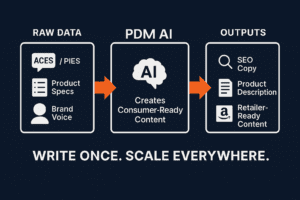According to Forbes, 74% of companies experience increases in lead generation when employing a committed content marketing plan.
Great marketing content doesn’t just sell a single product; it creates a compelling narrative that turns potential buyers into long-term customers.
Content marketing is a strategy focused on creating, publishing, and distributing valuable, relevant, and consistent content to attract and engage a specific target audience, with the ultimate goal of driving profitable customer action. In the automotive aftermarket, content marketing is especially powerful because of the technical nature of the products being sold to a specific audience.
By including content marketing in their marketing strategy, aftermarket parts businesses can more closely align themselves with the needs and behaviors of modern consumers, ensuring better engagement and higher ROI than traditional advertising methods.
Shift from traditional advertising to content marketing
Just 37% of B2C content marketers have a documented marketing strategy. (Content Marketing Institute)
Traditional marketing is becoming less prevalent as changing consumer preferences favor more interactive and personalized content marketing strategies.
Ad fatigue
Consumers are increasingly bombarded with ads across multiple platforms, leading to ad fatigue where they either ignore or even criticize overt advertising.
Limited engagement
Traditional advertising often provides a one-way communication path, which doesn’t engage customers or allow for interactions, feedback, or discussions.
High cost
Traditional advertising channels, such as TV, radio, and print, can be expensive, especially for small to medium-sized brands.
Difficulty in measuring effectiveness
Unlike digital marketing, traditional methods often lack the precise tracking and analytics tools necessary to gauge campaign effectiveness and ROI.
Changing consumer habits
As media consumption habits shift towards digital and streaming services, traditional advertising channels reach fewer consumers, particularly younger demographics who prefer online content.
Inflexibility
Traditional ads are static and can’t be easily updated or optimized once launched, unlike digital ads, which can be adjusted in real-time based on performance data.
Lack of personalization
Traditional advertising methods involve broad messages aimed at large audiences, lacking the personalization that today’s consumers expect, which is more effectively delivered through digital channels.
These limitations are prompting many businesses to reevaluate their advertising strategies and increasingly turn to content marketing and digital approaches that offer more flexibility, engagement, and measurable results.
Benefits of content marketing in the automotive aftermarket
83% of marketers believe it’s more effective to create higher quality content less often. (Source: Hubspot)
Content marketing in the automotive aftermarket offers the dual benefits of building brand authority and trust while enhancing SEO, thereby driving increased organic traffic and deeper customer engagement.
Enhanced customer engagement
Content marketing enhances customer engagement by fostering more interactive and meaningful relationships between businesses and their audience. Here’s how it achieves this:
Interactive content
Content like quizzes, polls, and interactive tutorials invite active participation rather than passive consumption. This engagement makes the customer’s experience more memorable and can strengthen their connection to the brand.
Regular updates and communications
Businesses keep their audience informed and engaged through consistent content delivery, whether via blogs, social media, or email newsletters. Regular interaction helps build a community around the brand, where customers feel involved and valued.
Feedback opportunities
Content marketing often opens opportunities for feedback, allowing customers to comment, share, and interact directly with the brand. This two-way communication helps businesses understand customer needs and respond effectively, enhancing customer satisfaction and loyalty.
Personalization
Advanced content marketing strategies use data analytics to deliver personalized content that resonates with individual customer preferences and behaviors. This tailored approach makes interactions more relevant and engaging, increasing the likelihood of conversion.
Increased brand visibility and authority
Consumers value transparency above all else, so sharing helpful content is crucial for establishing a brand leader in the aftermarket parts industry.
Expertise showcase
A business demonstrates its expertise and deep understanding of the industry by providing in-depth tutorials, insightful reviews, and data-driven product comparisons. This knowledge can help position the brand as a thought leader.
Trust building
Consumers tend to trust brands that offer valuable information without directly pushing sales. Educational content that helps solve problems or enhance the user’s knowledge can build this trust.
Content sharing
Valuable content is more likely to be shared among users and within online communities. Each share increases visibility, spreading the brand’s reach further.
Public relations boost
High-quality content can also attract industry media attention. Being featured or mentioned in publications enhances credibility and broadens visibility.
Increased SEO and organic traffic
Content marketing boosts SEO efforts, which in turn drives more organic traffic to a company’s website:
Keyword integration
Effective content marketing incorporates relevant keywords that potential customers use to search for aftermarket parts and services. By optimizing content with these keywords, businesses improve their search engine rankings.
Fresh content
Search engines favor websites that frequently update their content. Regular posting of articles, blogs, and videos signals to search engines that the website is active, which can improve its ranking.
Backlinking opportunities
High-quality content encourages other websites to link back to it. These backlinks are valuable for SEO, as they signal to search engines that other sites view the content as authoritative and trustworthy, boosting the website’s credibility and ranking.
User engagement metrics
Engaging content reduces bounce rates and increases time on site—two metrics that search engines consider when ranking sites. Engaged users typically interact with the content longer, further signaling the quality and relevance of the website to search engines.
Strategies in content marketing for aftermarket parts
A 2023 Global Report by Semrush reveals that articles containing at least one video tend to attract 70% more organic traffic than those without.
Instead of focusing on an immediate sale, aftermarket companies must focus on building long-term trust that resonates with customers and positions them more favorably on SERPs.
Educational content
Source: JEGS
Providing educational content such as tutorials, DIY guides, and product comparisons is an effective strategy for aftermarket brands. This approach attracts potential customers and educates them, empowering them to make informed purchasing decisions.
Tutorials and DIY guides
These help demonstrate the practical use and installation of products. By showing customers how to use or install parts themselves, businesses can reduce the intimidation factor, encouraging DIY enthusiasts to engage with their products.
Product comparisons
By comparing different products, businesses can help consumers easily understand the features and benefits of various options. This not only aids in the decision-making process but also positions the business as transparent and customer-focused.
Influencer partnerships
Sally McNulty / Borla Partnership
Source: Borla
Partnering with automotive influencers and thought leaders can significantly amplify a business’s credibility and reach.
Credibility boost
Influencers who are respected in the automotive community bring with them a loyal following and a sense of trust. Their endorsement can lend substantial credibility to a brand, making it more appealing to its audience.
Expanded reach
Influencers have the ability to reach niche groups that businesses might otherwise find difficult to engage. Their platforms provide a direct line to enthusiastic communities that are highly invested in their content.
Content amplification
When influencers share content or collaborate on projects, they amplify the message through their networks. This can lead to increased brand exposure, more traffic to the business’s website, and, ultimately, higher sales.
Video content
Source: MOOG
Thanks to digital consumption, video content is particularly effective in the automotive aftermarket sector for several reasons.
Visual demonstration capabilities
Many automotive products require precise installation processes that are best explained visually. Video content such as installation guides and product demonstrations can make complex information more accessible and understandable.
Increased engagement
Videos are more engaging and can hold the viewer’s attention longer than text or images alone. This engagement is crucial in driving deeper connections with the audience.
Behind-the-scenes looks
Videos that offer a glimpse into product development or day-to-day operations at a company help humanize the brand, fostering a sense of community and belonging.
SEO benefits
Search engines favor videos, especially when they are well-tagged and include relevant keywords in their descriptions. Videos can improve a business’s SEO, making it easier for potential customers to find it through search queries.
Product Information Management (PIM) systems make content management more efficient
A Product Information Management (PIM) system is a game-changer for content marketing, enhancing efficiency, accuracy, and personalization in impactful ways.
Centralized product data
PIM systems provide a centralized repository for all product information, which ensures consistency and accuracy across all content marketing materials.
Efficient content creation
By having accurate and up-to-date product information readily available, marketing teams can quickly and efficiently create content like blogs, product descriptions, and social media posts.
Improved personalization
PIM systems enable marketers to tailor content more precisely to specific customer segments by providing detailed product information that can be aligned with customer preferences and buying behavior.
Multichannel consistency
With PIM, marketing teams can ensure consistent product information across multiple channels, from websites and mobile apps to social media, enhancing the brand’s credibility and customer experience.
Faster time-to-Market
Having all product information in one place allows for faster creation and distribution of marketing content, helping businesses respond swiftly to market trends and new product launches.
PDM is your ally in the digital age
Unlock the full potential of your product data with our advanced Product Information Management (PIM) solution. Schedule a personalized demo today and see firsthand how we can help streamline your data management processes, enhance data accuracy, and supercharge your marketing efforts.

More Resources
2024 laws and regulation changes that may affect the automotive aftermarket
What is a PIM and and why it is important for aftermarket brands
Understanding the role of certifications and standards in aftermarket parts quality



